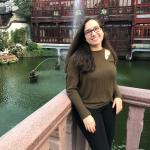Support
Through my semester abroad my goal was to discover the different stories Chinese cities have to offer. As a global studies major and Asian studies minor, my research in China focused on challenging the oriental views Western countries make of Asian countries , in this case China. Through my time in Shanghai, Beijing and Chengdu, I discovered how multifaceted Chinese cities can be.
Living in Shanghai I was exposed to the megacity that is the New York City equivalent in Asia. Its massive skyscrapers and rich history could be found at every corner. Much like New York City, Shanghai is a melting pot with cultures from all over China, Asia and even the Western Hemisphere. Through my business classes I was able to able to go the the Volkswagen factory and visit Zhangjiang Hi-Tech Park, as known as the Silicon valley of Shanghai. My first venture out of Shanghai was to Chengdu, the capital of southwestern China's Sichuan province. Famous for its spicy food, rich history that dates back to at least the 4th century B.C. and it's very popular Chengdu Research Base of Giant Panda Breeding, where visitors can view endangered giant pandas in a natural habitat. It it's the third most populous city in China and its boom is just beginning. The cities popularity came from a very different place compared to Shanghai. It has a beautiful juxtaposition of historic builds with highrises. Chengudes location in the southwest part of the country allows it to attract people from China’s western border. I was fortunate enough to walk down and go into a few shops from the Tibetan community that resides in Chengdu. The divides between Tibetans and Chinese was evident, for as soon as I stepped onto the “Tibetan Strip” which is a long road where all there shops are, it was a different world. Even through the culture clashes Tibetan’s rich history, its pandas and origin adds to Chengdu's uniqueness. A few weeks after coming back to Shanghai I ventured off to Beijing, the capital of China. This Chinese city is filled with historic significance that stretches out 3 millennials. Prior to my study abroad semester in Shanghai I believed all of China to be Beijing, but after visiting this historic city after seeing two other major cities in China, I realized how erroneous my assumptions were. Walking through the massive Tiananmen Square pedestrian plaza past the site of Mao Zedong’s mausoleum, going through the Forbidden city, climbing the Great Wall and seeing the Summer Palace, showed me China’s core. The history that is found in Beijing can hardly be put into words. It is without a doubt China’s political stronghold, for it is mainly composed of historic buildings that have been unchanged through the passage of time. These three cities all tell very different stories about China and all three are very legitimate.
In my search of the true stories behind Chinese cities I discovered that their poor representation in Western countries, like Edward Said would say, the simplified representations of Asia says a lot more about Western countries than of countries like China. Asian cities, culture and language cannot be easily summed up in a neat pile, it is far more complicated than that. I plan on using this information to further my SYE through the exploration of how Western countries contract minority identities and aren't challenged. China showed me three powerhouse cities, that were hardly anything alike and yet could prior to going to China I believed all three were the same. Part of challenging the common rhetoric of Asian countries in the West is admitting these biases and be willing to ask for the true tales behind Asian cities.
